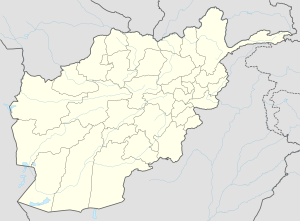Shighnan
| Shughnan | |
|---|---|
| Location in Afghanistan | |
| Coordinates: 37°37′0″N 71°27′0″E / 37.61667°N 71.45000°ECoordinates: 37°37′0″N 71°27′0″E / 37.61667°N 71.45000°E | |
| Country |
|
| Province | Badakhshan Province |
| Districts | Shighnan District |
| Population | |
| • Total | 24,000 |
| Time zone | UTC+4:30 |
Shighnan (also Shignan, Shugnan, Shughnan, Khughnan in the local language) (Persian: شغنان) is an historic region whose name today may also refer to a town and a district in Badakhshan Province in the mountainous northeast of Afghanistan and also a district in Gorno-Badakhshan Autonomous Province in Tajikistan. The administrative center of the Shighnan District of Afghanistan is called Qaleh Barpanjeh (قلعه برپنجه). The administrative center of the Shughnon District of Tajikistan is called Khorogh.
The Afghan Rushan (Rushan is also a separate district in Tajikistan) falls under the administrative rule of Shughnan district, and is referred to as Rushan sub-district (i.e. Rushan Alaqadari). There are about ten sizable and many more smaller villages in the Shughnan district of Afghanistan. These villages include, south to north, Darmarakht, Wiyod, Wiroodhj, Bashor, Vuzh-Pidrudh, Dhishahr, Shidwood, and Tsaghnod. Note; the village names are given as they appear in the local language. Population of the Afghan district totals approximately 24,000 residents. Some of the bigger villages in the Tajik side of Shughnan include, south to north, Darmarakht, Porshnev, Buni, Sokhcharv, and Rosht Qala.
In ancient times the area was known for its ruby mines, which are mentioned in the writings of Marco Polo:
In modern times Shughnan and its vassal Roshan were states whose native rulers, the mirs of Shighnan, claimed descent from Alexander the Great. The archaeologist Marc Aurel Stein wrote: "North of Shughnan lies Roshan, ruled usually by relatives of the old chiefs of Shughnan... there is no proof, however, to their genealogical claims." [2] Both states were conquered by Abdur Rahman Khan in 1882, but were assigned to Russia by the Durand agreement of 1893. In an 1895 agreement between the British and Russia, Moscow agreed to hand over all districts previously occupied by her on the left bank of the Panj, or upper Oxus, to Afghanistan in exchange for lands on the right hand bank in Darvaz. The Russian-controlled half of Shughnan was incorporated into to the Gorno-Badakhshan oblast in 1925, which was merged into the newly formed Tajikistan in 1929.
...
Wikipedia

